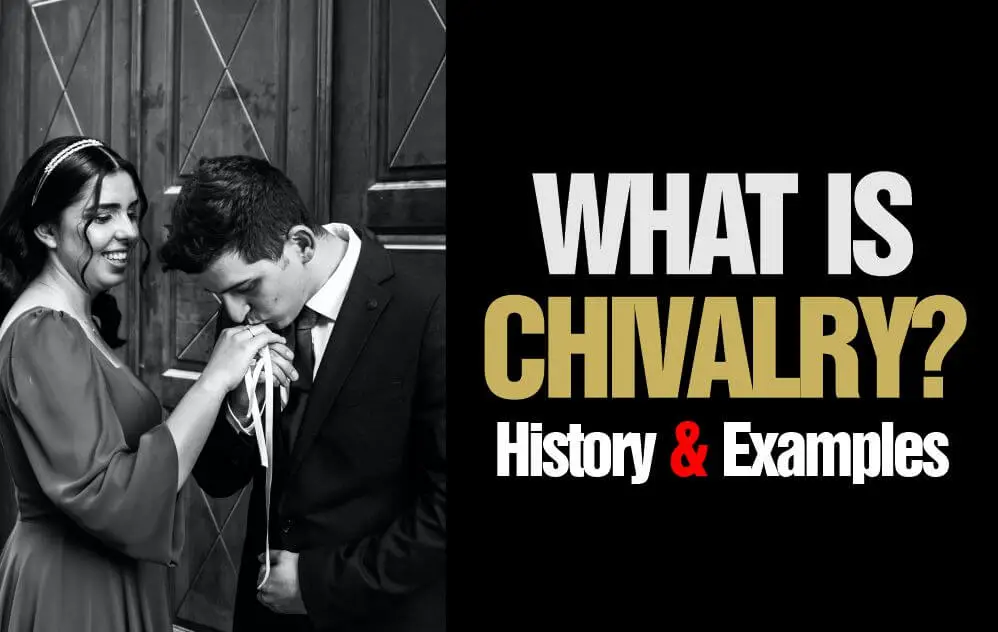People, especially women are swept off their feet when a gentleman is dangerously polite. But chivalry is not all about women. What is chivalry?
Whether this once revered knightly virtue is dead or not is left for every individual to answer as everyone has a different perception of people’s actions.
For some, chivalry is their weak point, and to others, it’s an overused strategy with a worn-out enchantment.
One thing that has remained, however, is that chivalry held sway, and still does today when it is delivered in the right situation.
This article is going to dissect the concept of chivalry – its meaning, history, examples, how it has fared in modern times, and frequently asked questions on the subject.
Table of Contents
- What is Chivalry? Definition and Meaning
- Overview of the History of Chivalry
- Different Interpretations of Chivalry in Different Cultures?
- Key Principles of Chivalry
- Code of Conduct for Knights
- Training and Education of Knights
- Women and Chivalry
- Legacy and Influence of Chivalry
- Ways Chivalry Can Be Observed
- Why is Chivalry Seen as a Thing of the Past?
- What are the Modern Applications of Chivalry?
- The Challenges of Chivalry
- Balancing Chivalry with Modern Societal Standards
- Wrapping Up
- Frequently Asked Questions About Chivalry
What is Chivalry? Definition and Meaning
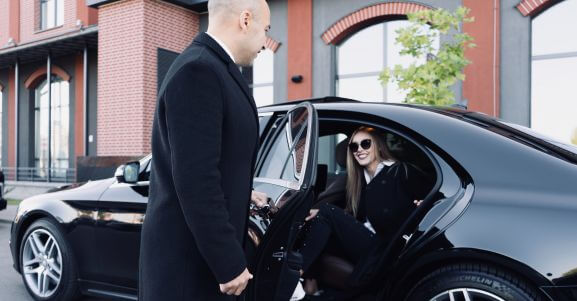
Chivalry is a code of conduct or behaviour that originated in medieval Europe, mainly among the knight class characterized by absolute politeness and courtesy.
It is a knightly virtue cloaked in honour, bravery, decency, empathy, respect, generousity, and loyalty. Chivalry protected the weak and defended the oppressed, especially women and children in the time past.
It gave rise to the adoption of courtly love, which mandated men to treat women with reverence, kindness, and devotion. Okay, maybe it was not ‘mandated’ but required men to extend a goddess devotion to women.
Why this happened is not clear in history, but women were treated with utmost care and respect and that is what gentlemanly conduct revolves around.
Related: 15 Reasons to Believe that Chivalry is Active in Modern Society
It also included gallantry in wars and battles to receive the honour of valour which was a ticket to the admiration of the public.
Also, among the gentlemen’s etiquettes are the exhibition of fair play, mercy, and upholding the rules of engagement.
It is important to point out that chivalry varied from group to group. Each group created their own chivalric ideology to reflect their perspective and needs.
But however, the fundamental principles were the same.
If chivalry is dead and has lost its original context, its values and morals are still relevant today in various forms of social and personal interactions.
Related: The Basics of Masculinity and Manliness
Overview of the History of Chivalry
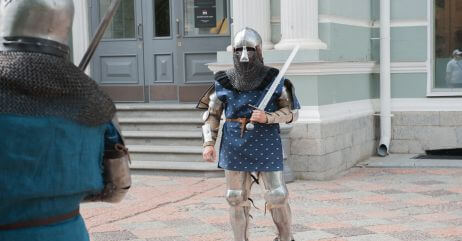
The origin of chivalry can be traced back to the 11th century, during the Middle Ages. The medieval knights were initially warriors who fought for their lords in exchange for land or other rewards.
As the feudal system evolved, knights became more prominent and began to hone a code of chivalry. They were expected to be brave in battles, respect their lords and ladies, and offer protection to those who were weaker.
The chivalry code of conduct was first written down by the French knight Geoffroi de Charny in the 14th century. It outlined the expected behaviour of knights, including their attitudes toward women, the poor, and their opponents in battle.
Chivalry also included the idea of courtly love, which was a romanticized concept of love that placed women on a pedestal and revered them as pure and virtuous.
This idea was popularized in literature such as the works of Chretien de Troyes and the stories of King Arthur and his Knights of the Round Table. The influence of chivalry declined during the Renaissance, as warfare became more professionalized and less focused on the ideals of knights.
However, its legacy continued in the popular imagination, with romanticized versions of knights and the subject appearing in literature, film, and other forms of media to this day.
Related: Differentiating Gentlemen and Players in Dating
Chivalry’s Association with the Christian Church
Chivalry is often associated with the Christian Church as a result of its strong connection to the teachings and values of Christianity during the Middle Ages. The Church’s role in shaping and upholding the knightly virtues through its vast influence on society through education and knightly orders.
Here are ways chivalry connected with the Christian Church:
Moral and Spiritual Guidance
The Christian Church provided moral and spiritual guidance to knights by preaching virtues like reverence, humility, justice, and charity.
These virtues were seen as necessary for knights to uphold and were in line with the teachings of Jesus Christ.
The Church encouraged knights to dedicate themselves to the service of God and to protect the weak and defenseless, which formed the basis of chivalric codes.
Related: Online Chivalry: How to Interact Like a Gentleman
Education and Knighthood Ceremonies
The Church took it upon itself to educate young boys who aspired to become knights.
They would be sent to monasteries or serve as pages in noble households, where they received religious instruction, learned basic literacy, and were taught the principles of chivalry.
As part of the knighthood ceremonies, which were often held in churches, knights took sacred oaths, making vows of loyalty, bravery, and honor, placing them firmly within the sphere of the Church.
The Role of the Church in Warfare
Wars played big roles in medieval times and the Church regulated them through the concept of the ‘just war’, which provided knights with guidelines for noble behaviour during such times.
It was called just war as it was necessary to defend and protect the people but they were obliged to observe mercy and forgiveness towards enemies.
This checked the indiscriminate violence that comes with war.
Religious Orders of Chivalry
The Christian Church established and supported various knightly orders, such as the Knights Templar, the Knights Hospitaller, and the Teutonic Knights.
These orders combined the ideals of chivalry with religious devotion. T
hey were saddled with keeping Christian pilgrims from harm, defending Christian territories, and helping the sick with medical assistance.
The knightly orders had their own codes which were integrated with that of chivalry.
Chivalry’s association with the Christian Church hinged on the Church’s big role in medieval society, its influence on education and moral teachings, and its efforts to guide knights in their pursuit of honor, justice, and service to God.
That was how the Church played a vital role in upholding chivalry, infusing it in Christian values during the Middle Ages, and till today, the Christian Church still awards Knights as an honour.
Suggested: Obsolete Acts of Chivalry You Should Shun
Different Interpretations of Chivalry in Different Cultures?
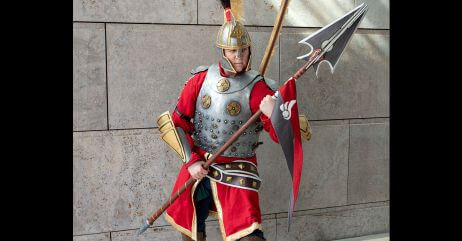
Different cultures have interpreted the concept of chivalry differently, depending on their traditions and values.
Here are some of the interpretations given in different cultures:
Chivalry in Japan: In Japan, the samurai warrior class had its own code, known as Bushido, which had similar themes to European chivalry. The Bushido code emphasized loyalty, honour, and respect, with an emphasis on self-discipline and self-control.
Chivalry in Islamic Cultures: In medieval Islamic cultures, the concept of futuwwa was similar to chivalry, emphasizing honour, generosity, hospitality, and bravery. The concept was often linked to Sufism, a mystical form of Islam that emphasized spiritual development.
Related: 10 Rules of Courtly Romance
Indian Chivalry: In India, the concept was embodied in the concept of dharma, which encompassed duty, morality, and righteousness. The ideal of chivalry was exemplified in the stories of heroes like Rama and Arjuna, who demonstrated courage, honour, and loyalty.
Chinese Chivalry: In China, the concept was embodied in the ideal of the “gentleman” or “nobleman,” known as junzi. The junzi was expected to exhibit moral integrity, wisdom, and benevolent leadership, and to put the interests of the community above his own.
If chivalry is dead, these virtues would also be dead, or so I think.
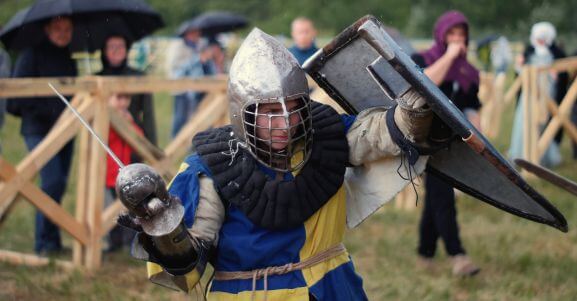
Key Principles of Chivalry
In the medieval era, knights symbolized the essence of chivalry, a code of conduct rooted in noble virtues. Though often romanticized, these knights strived to live by the key principles of loyalty, courage, and honor.
Loyalty and Devotion: Knights upheld loyalty as a crucial tenet. Sworn to lords and realms, their unwavering devotion brought stability and unity. Oaths were solemn commitments, pledging obedience and protection. Breaking them carried grave consequences, tarnishing honor and reputation.
Courage and Bravery: Knights were first and foremost warriors, highly trained in the art of combat. However, their bravery extended beyond physical prowess; it encompassed spiritual, mental, and moral aspects. A knight’s code of honor demanded them to exhibit strength, prowess in battle, and unwavering bravery in the face of fear.
Honor and Integrity: In the realm of chivalry, honor was of utmost importance to a knight’s reputation. A knight’s deeds on and off the battlefield determined their honor, impacting their social standing and how they were perceived by their peers. Upholding honor meant acting in accordance with the chivalric virtues, transcending merely one’s personal gain.
Chivalric Virtues and their Relation to Integrity
Chivalry demanded knights embrace virtues such as truthfulness, fairness, humility, and justice. These chivalric virtues formed the foundation of a knight’s integrity, ensuring their actions mirrored the highest standards of honor. A knight’s integrity was reflected in how they treated opponents, and those of lesser stature, and upheld justice even when tempted to do otherwise.
Check out our post on the 12 lessons from the Code of Chivalry.
Code of Conduct for Knights
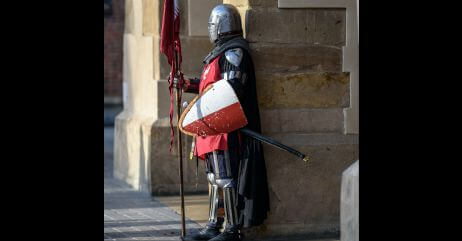
Knights assumed a prominent role that extended beyond their prowess in battle. They were not only fierce warriors but also guardians of justice and exemplars of virtue.
To fulfill their noble duty, knights adhered to a strict code of conduct, ensuring they conducted themselves with respect, upheld the weak, and championed fairness and justice.
Respect and Courtesy: In medieval times, social status hinged on etiquette and manners. Knights adhered to chivalric customs, treating all with respect, from nobles to peasants. Such conduct elevated them, fostering mutual respect and honor within society.
Protection of the Weak and Defenseless: Knights held a significant duty to shield the defenseless, distinguishing them from mere warriors. Legends depict them courageously defending the vulnerable, whether rescuing damsels or safeguarding communities. These stories exemplify the knights’ profound commitment to their code of honor and duty.
Fair Play and Justice: Central to the knightly code was the principle of fair play and justice. Knights were obligated to champion justice, prioritizing fairness over personal gain. Resolving conflicts among nobles and within their domains, they epitomized virtue’s triumph and a just society’s foundation.
Historical and legendary figures, such as Sir Galahad and Sir Gawain, symbolized knights’ unwavering dedication to these values. By upholding their code, knights stood as community pillars and timeless icons of honor.
You might want to read the code of chivalry proper.
Training and Education of Knights
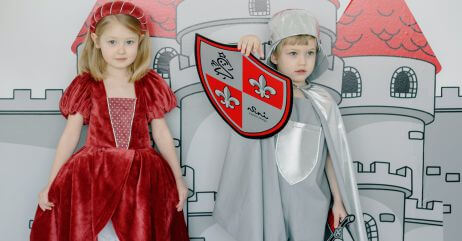
The training and education of knights held a crucial role in medieval society. From a young age, aspiring knights would undergo a rigorous process to mold them into skilled warriors, embodying the ideals of chivalry and honor.
Let’s delve into the different aspects of their upbringing and the virtues they were taught to uphold.
Knightly Education and Upbringing
Life of a page and squire: The journey towards knighthood began in childhood, around the age of seven, as a page. Pages served in noble households, learning basic manners and etiquette. They were exposed to various aspects of courtly life, observing their superiors and gaining an understanding of the societal expectations placed upon them. As they grew older, usually around their early teenage years, pages would become squires.
Importance of Education and Martial Training: Education played a crucial role in the training of knights. Alongside mastering their martial skills, young squires were taught music, literature, and mathematics. This well-rounded education was deemed important to cultivate their minds and instill a sense of nobility and refinement. Martial training, on the other hand, focused on the development of physical strength, agility, and combat techniques. Swordsmanship, horsemanship, and the use of other weapons were all part of their daily training routine.
Knightly Virtues and Skills
Development of Character and Inner Values: Knights were expected to uphold a code of chivalry, rooted in honor, loyalty, and integrity. Through a combination of education and personal tutelage, these future knights were taught the virtues of courage, humility, fairness, and justice. Stories and chivalric tales often served as moral examples, allowing young knights to understand the importance of their actions and the impact they could have on those around them.
Martial Skills, Weaponry, and Combat Techniques: Knightly training focused on war skills, covering combat, horseback riding, and weaponry. Knights learned battle strategies, armor use, and martial tactics. Education balanced physical and intellectual growth, emphasizing chivalry and virtue. Knights displayed prowess in battle and moral values, becoming respected warriors with honor in medieval society.
Women and Chivalry

In medieval romance and chivalry, one cannot overlook the significant role that women played in shaping this cultural phenomenon.
Admired and revered, women became the embodiment of courtly love and were central figures in the concept of chivalry.
The Concept of Courtly Love and Influence of Troubadours
The Concept of Courtly Love which was deeply rooted in the troubadour tradition and romantic literature, played a pivotal role in shaping the perception of women in medieval society.
Troubadours were medieval poets and musicians who composed songs that celebrated chivalry and idealized relationships between knights and noblewomen.
These songs, known as chansons de geste, romanticized the idea of courtly love, wherein a noble knight would serve and adore a married noblewoman who was typically unattainable.
This idealized love, far from physical desires, emphasized the pursuit of spiritual and emotional connection.
Relationships between Knights and Noblewomen
In medieval society, women, particularly noblewomen, faced both expectations and limitations.
While they were regarded as objects of admiration and desire, they were also subjected to strict gender roles and expected to observe virtuous qualities such as modesty, beauty, and piety.
These expectations often confined noblewomen to a life of seclusion within their estates and castles, where their main role was to manage the household and bear children.
However, through their influence on knights and the chivalric culture, women managed to exert some degree of power and authority.
Noblewomen played a crucial role in shaping chivalric culture by cultivating knights’ virtues and manners. They were responsible for the education and upbringing of young knights, shaping their moral standards and refining their behaviour.
They often served as the inspirations behind a knight’s quests and battles, encouraging them to pursue great deeds and uphold the code of chivalry.
Their influence extended to the courts, where they acted as mediators and advisers, lending their wisdom and counsel to their husbands.
Influence of Women on Chivalry
The influence of women on chivalry was not limited to the realm of romance and ideals; their power extended to the practical aspects as well.
Noblewomen were often the custodians of their husbands’ estates during times of war, demonstrating their resilience and leadership skills.
Their importance in managing finances, organizing resources, and ensuring the smooth running of the estate cannot be underestimated.
Relationship between Knights and Women
Indeed, women and chivalry shared a reciprocal relationship. While women were expected to inspire knights to uphold chivalry’s ideals, it was through their influence that the concept of chivalry evolved and flourished.
The noblewomen of medieval society helped shape the definition of a “true knight” and influenced the expectations placed upon knights by society.
Legacy and Influence of Chivalry
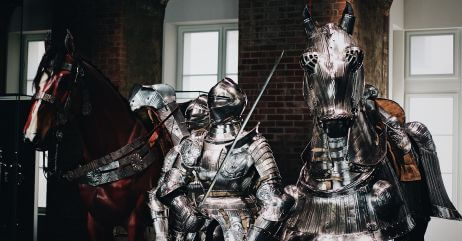
The legacy and influence of chivalry have had a significant impact on society throughout history. This noble code of conduct, embraced by medieval knights, dictated their actions and set forth a high standard of behaviour.
However, as time passed, chivalric ideals experienced a decline and transformation.
Here is more…
Factors Contributing to the Decline of Chivalry
- Technological Advancements: The development of firearms and other battlefield innovations made traditional knightly combat less relevant.
- Changing Societal Values: The Renaissance and Enlightenment eras brought about a shift in focus from feudal loyalty to individualism and reason.
- The Decline of Feudalism: As a central authority and structured feudal systems gave way to more centralized monarchies, the need for knights as defenders and protectors diminished.
- The rise of mercenary armies: As professional armies became more common, the role of the knight as a warrior became less important.
- The Protestant Reformation: The religious upheaval of the 16th century questioned the values and morals associated with chivalry.
- The rise of the middle class: With the growth of trade and commerce, the feudal system began to decline, and with it, the dominance of knights.
- The Age of Enlightenment: The philosophy of reason and rationality challenged the traditional values of chivalry.
- The Industrial Revolution: The social and economic changes brought about by industrialization made chivalry appear outdated and irrelevant.
Related: Examples of Courtly Romances
Evolution of Knighthood and its Role in Modern Times
While the traditional knight has largely vanished, remnants of chivalric ideals persist in various ways:
Military Honour Codes: Modern-day military organizations often incorporate elements of chivalry, emphasizing courage, loyalty, and self-sacrifice.
Leadership and Ethical Principles: Many organizations draw inspiration from chivalry, emphasizing values such as trust, honor, and respect.
Ceremonial Roles: In certain countries, knighthood still exists as a ceremonial honor, bestowed upon individuals for outstanding service or achievements.
Moving beyond its historical context, chivalry has found its way into popular culture, becoming a captivating and romanticized subject.
Depictions of Chivalry in Literature and Films
Iconic works such as Sir Thomas Malory’s “Le Morte d’Arthur” and Miguel de Cervantes’ “Don Quixote” offer vivid portrayals of chivalry, exploring its virtues and pitfalls.
Films like “Monty Python and the Holy Grail” and “A Knight’s Tale” have humorously played with chivalric concepts, demonstrating the enduring fascination with these ideals.
Reimagining Chivalry in the Modern World
In the 21st century, chivalry has been interpreted in new ways, adapting to modern ideals and challenges:
Gender Equality: Chivalry has been redefined to include acts of kindness and respect toward all individuals, regardless of gender.
Online Chivalry: Concepts such as “netiquette” highlight the importance of respectful and courteous behaviour in digital interactions.
Ways Chivalry Can Be Observed
Chivalrous behaviours are behaviours people put up that show respect, politeness and a deliberate desire to please. While we have a dedicated post on examples of chivalry here, here are some ways chivalry can be exhibited:
- Holding doors open for others
- Offering to carry someone’s heavy luggage or belongings
- Paying for a meal or drink when going out with someone
- Walking a woman home or to her car to ensure her safety
- Standing up when a woman enters the room
- Offering your coat or jacket to someone who is cold
- Pulling out a chair for someone to sit down
- Offering your seat to someone who needs it more
- Giving compliments and showing appreciation for others
- Apologizing when you’ve done something wrong and taking steps to make things right.
Related: The Right Way a Gentleman Treats a Lady
Why is Chivalry Seen as a Thing of the Past?
Chivalry is seen as a thing of the past because the concept is believed to have since become irrelevant due to changing cultural values and social norms. In today’s society, gender roles, relationships, and communication have greatly transformed from what they were in medieval Europe.
While some may still appreciate traditional expressions of chivalry, such as opening doors or paying for meals, others may view these actions as unnecessary or even condescending.
Also, some actions traditionally associated with chivalry, such as protecting women or fighting in their defense, may be seen as patronizing or even sexist. Here is an extensive article on reasons why people say chivalry is dead.
What are the Modern Applications of Chivalry?
- Respecting and protecting women’s rights and safety
- Practicing courteous and respectful behaviour towards others
- Showing honour, generosity, and bravery in daily life
- Acting as a positive role model in the community
- Volunteering and supporting charitable causes
- Being a responsible and loyal partner, friend, and family member
- Upholding ethical and moral principles, such as honesty, integrity, and justice
- Striving for self-improvement and personal growth.
Here is a comprehensive article on modern chivalry for gentlemen.
The Challenges of Chivalry
Chivalry has had its share of challenges through the centuries. It has been ridiculed, challenged, and described as effeminate.
This is why I do not hold it against people who say chivalry is dead. I have filtered out some of the challenges chivalry has faced in its lifetime, they are as follows:
Critiques of Chivalry as Outdated or Patriarchal
The majority criticizes chivalry from many different angles of reasoning. The most glaring is accusing chivalry of patriarchy that asserts itself to lord over women.
Let’s take a look…
- Gender Equality: One major criticism of chivalry is that it is rooted in patriarchal conduct that reinforces gender roles and promotes male dominance and subdues women. Critics argue that chivalrous behaviour traditionally expects men to be protective and chivalrous towards women while positioning women as weak and in need of protection. This perpetuates unequal power dynamics between genders.
- Exclusionary Nature: Another criticism describes how people who do not conform to traditional gender roles are excluded or manipulated out of the scheme of things. This is evident with the marginalization of non-binary or gay individuals.
- Reinforcement of Gender Stereotypes: Another criticism is that chivalry promotes gender stereotypes by assigning behaviours and expectations to individuals based on their sex, instead of allowing them to choose where they want to belong. For example, it may assume that women should be passive and in need of male protection, while men should be strong and dominant.
- The stigma of Being Labelled Weak: Most men in modern times are called weak and lack a spine when they are too soft and chivalrous to women. We have seen so many movements attacking the worship of women, calling it unnecessary. Because of this, some men have shielded their chivalrous side to please the times.
Balancing Chivalry with Modern Societal Standards
Chivalry is the nature of man and cannot be killed. This does not mean it cannot be suppressed just as it has been since modern times.
But here are ways to incorporate chivalry into modern situations:
- Adaptation to Modern Realities: Critics urge chivalry to evolve with societal changes, embracing inclusivity, respect, consent, and equality for all, regardless of gender, in line with the modern social landscape.
- Encouraging Agency and Independence: Critics highlight empowering men and women to make independent choices, rather than relying on chivalry, to break traditional gender roles and define their identities and relationship roles.
- Balancing Selflessness and Personal Boundaries: Chivalry promotes selfless acts and puts the well-being of others before its own, but critics argue that individuals should also prioritize their own well-being and establish healthy boundaries. It is important to strike a balance between being chivalrous and maintaining personal agency and self-care.
- Addressing Intersectionality: Critics advocate for chivalry to recognize intersectionality, addressing discrimination like racism and ableism, and ensuring inclusivity by acknowledging diverse experiences and struggles of individuals beyond traditional ideals.
Wrapping Up
Chivalry is a code of conduct that emerged in medieval Europe, embodying the virtues of honour, courage, courtesy, and justice.
It originated from the knightly class and evolved over time to become a social ideal.
It was able to influence various aspects of medieval society, including warfare, courtly love, and religious beliefs.
Examples of chivalry can be found in legendary figures such as King Arthur and his Knights of the Round Table, as well as in historical figures like Richard the Lionheart and Joan of Arc.
Despite its decline in modern times, the concept of chivalry continues to inspire admiration for its noble ideals.
Frequently Asked Questions About Chivalry
What is the true meaning of chivalry?
Chivalry is a code of conduct, specifically for knights and gentlemen, that emphasizes the virtues of honour, valor, courage, loyalty, and courtesy towards women.
It encourages men to act with humility, respect, and generosity towards others, to protect the weak and defenseless, and to uphold justice and truth.
Essentially, it is about behaving with noble character and treating others with kindness, respect, and honour.
What does chivalry mean in a relationship?
It refers to the practice of courteous behaviour towards a person, especially a woman. It involves performing small acts of kindness, such as opening doors, holding hands, or offering compliments. Chivalry also includes being protective, supportive, and putting your partner’s needs before your own. It’s about treating your partner with kindness, respect, and dignity as an equal partner in the relationship.
What does it mean chivalry isn’t dead?
The phrase “chivalry isn’t dead” means that the traditional qualities of chivalry, such as honour, respect, kindness, and politeness towards women, have not completely disappeared from modern society.
Despite the evolving attitudes towards gender roles and expectations, some people still adhere to the principles of chivalry and strive to treat women with respect and dignity.
Is chivalry a good thing?
The idea of chivalry is rooted in respect, honour, courage, and protecting the weak and defenseless. While these values are generally considered positive and honourable, some may argue that the concept of chivalry can also reinforce gender roles and stereotypes. Ultimately, the interpretation of the concept is subjective and can vary depending on cultural and historical contexts.
Is chivalry dead in relationships?
There is no universally agreed-upon answer to whether chivalry is dead in relationships. Some people believe that modern-day relationships have moved away from traditional gender roles and expectations, while others argue that chivalrous behaviour is still appreciated and valued by many women.
In the end, it depends on the individual and their particular perspective on what constitutes respectful and considerate behaviour in a relationship.
Why has chivalry died?
One reason why some people feel chivalry is dying is that traditional gender roles are changing, leading to confusion and uncertainty in interactions between men and women.
Additionally, the rise of technology and online communication has reduced face-to-face interactions, making it harder to apply the principles of chivalry.
Also, some people may view chivalry as outdated or misleading, as it often idealizes women as passive and helpless, and men as the only ones responsible for their protection and well-being.
Pyo Merez is a men’s lifestyle enthusiast and writer about the gentleman’s place and impact on society. Raised by a distinguished gentleman dad, he offers unique insights into how the mind of a gentleman works and how societal norms shape gentlemen’s identity and vice versa.
Through his insightful articles, Pyo taps into the depths of gentleman culture to provide perspectives on etiquette and manners in modern society.

